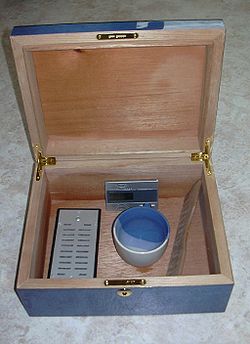

A humidor is a humidity-controlled box or room used primarily for storing cigars, cigarettes, cannabis, or pipe tobacco. Either too much or too little humidity can be harmful to tobacco products; a humidor's primary function is to maintain a steady, desirable moisture level inside; secondarily it protects its contents from physical damage and deterioration from sunlight. For private use, small wooden boxes holding a few dozen or fewer cigars are common, while cigar shops may have walk-in humidors. Many humidors use hygrometers to monitor their humidity levels. When used and maintained properly, humidors can keep cigars fresh and in perfect condition for decades. [1]
Contents
- Types
- Walk-in
- Cabinet
- Desktop
- Travel
- Cannabis
- Electric
- Construction
- Maintenance
- Humidity
- Temperature
- See also
- References
- External links
Another use for a humidor is controlling the moisture level in a baseball, which can have a pronounced effect on its response when hit with a baseball bat. This phenomenon was so great that in order to put an end to much controversy, in 2002, nine years after joining the league, the Colorado Rockies started storing their game balls in a large walk-in humidor at their home stadium, [2] thus counteracting the effects of the low humidity due mainly to Denver's famous mile-high altitude of around 5,280 feet above sea level. After the change, various offensive and defensive statistics at Rockies home games, especially the number of home runs, were found to be more in line with the rest of the league. In 2018 the Arizona Diamondbacks, whose Phoenix home field is affected by the arid Sonoran Desert climate, became the second Major League Baseball team to use a humidor. [3]